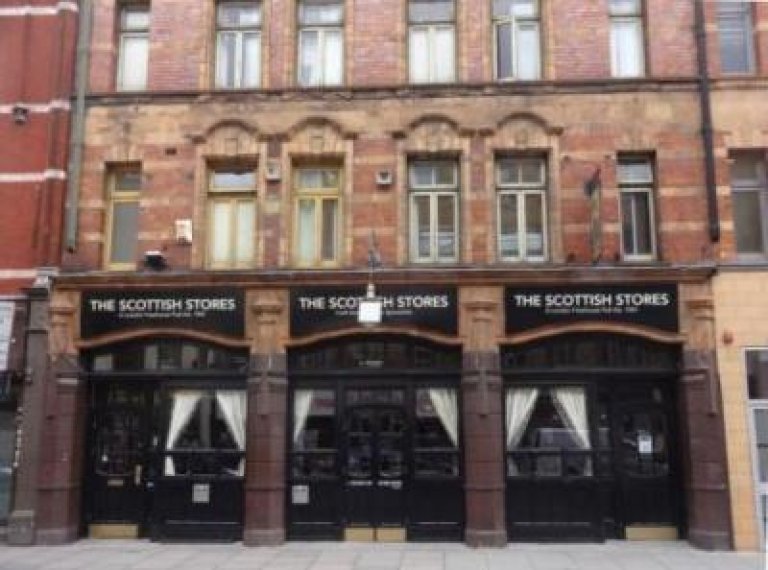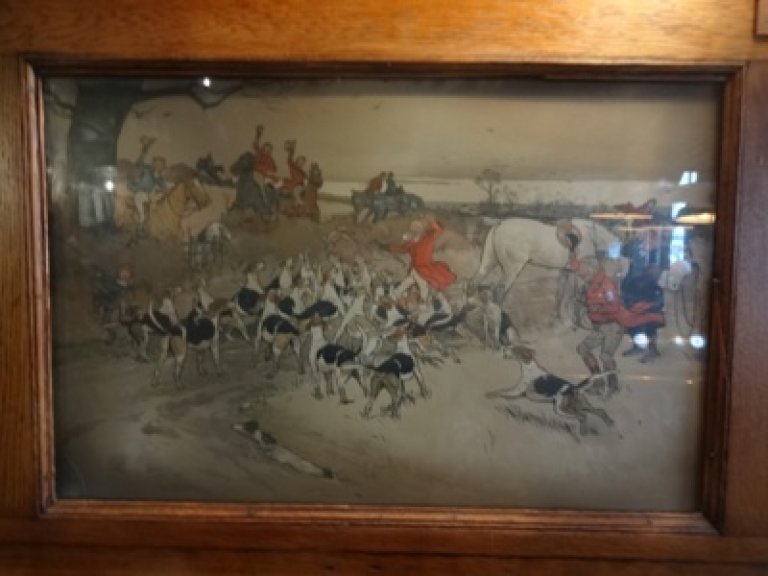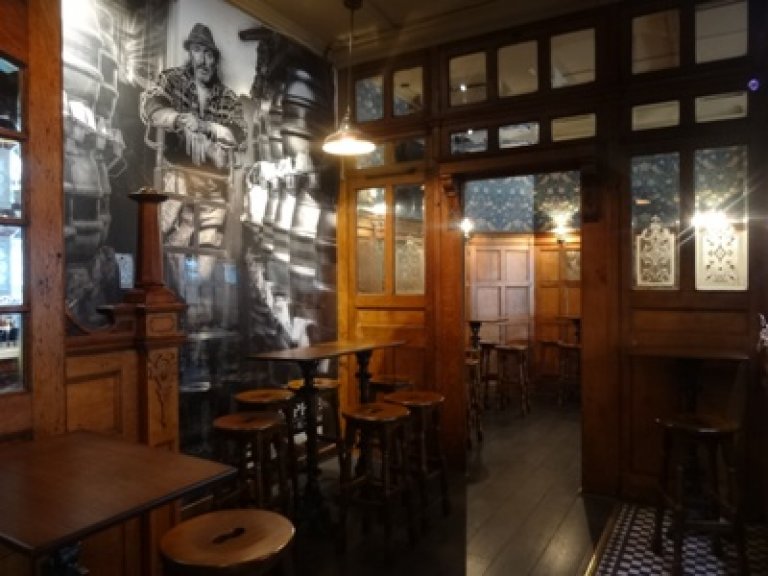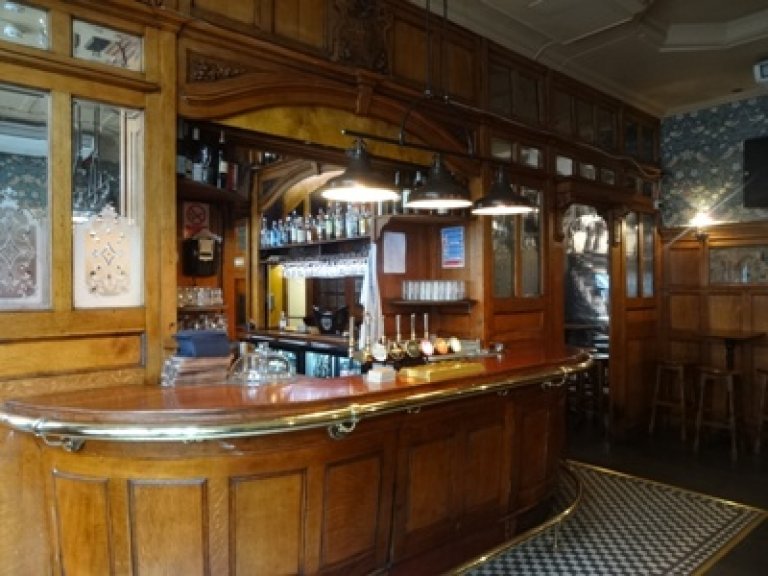Scottish Stores
2-4 Caledonian RoadKings Cross
N1 9DU
This pub is not only a grade II listed building, it is also a Three Star pub on the Campaign for Real Ale’s (CAMRA) National Inventory as having an interior of outstanding national historic importance, and the description is as follows: “Five-storey building designed in 1900-1 by architects Wylson and Long, probably for James Kirk. The interior is of a central servery surrounded by three distinct areas created by two screens with doorways in them - one screen runs back from the street front and has etched glass panels – the other screen is parallel to the street incorporating the bar back with shallow double-curved arches. The woodwork in the servery has a curious mixture of Gothic and Jacobean detailing. The front bar has fielded panelling to two-thirds height, the front bar counter has some new wood and the lower shelves have been replaced by fridges. Note the figure ‘2’ to the side of the middle double (disused) doors. Right hand bar has fielded panelling to two-thirds height with a set of coloured lithographs of hunting scenes by Cecil Aldin of 1900, set into frames in the panelling. High up over the bar-back there is a cartouche inscribed 'THE SCOTTISH STORES 1901' and the curved bar counter has cupboards. There is a figure ‘1’ on the inside of the right hand (disused) door. In the rear area is a staircase with and newel post with Jacobean detailing and an octagonal finial of Arts and Crafts character. A doorway in the screen leads back to the front bar. In front of the left and right entrances the remnants of ‘The Scottish Stores’ mosaics have recently been covered over by modern tiling (they say with the agreement of Historic England)."
History in a name: "The Flying Scotsman was the name given by the London and North Eastern Railway (LNER) in 1924 to the former Special Scotch Express, an express train service between London and Edinburgh. The LNER Class A3 4472 Pacific locomotive built in 1923 to a design by Sir Nigel Gresley is also named the Flying Scotsman."
The listing description is as follows: “Includes: Nos.2-4 The Flying Scotsman P.H. CALEDONIAN ROAD. Offices, and public house, with offices and flats above. 1900-01. By Wylson and Long, probably for James Kirk. Brown glazed brick and buff terracotta, roof obscured by parapet. Five storeys, four windows to Pentonville Road, eleven to Caledonian Road, the corner of the building curved in plan. The ground floor of nos 272-276 Pentonville Road is of c.1930; that of nos 2-4 Caledonian Road is almost certainly the original pub frontage of 1901: three bays flanked by six-sided columns of pink granite with banded rustication, capitals in the manner of a pulvinated frieze, and a triangular fin on the front face running down through the top three blocks on the columns. Glazed wooden screens between piers with pilasters and cornice, and doors at either end and in the middle. The doors have segmental-arched heads, and panelling details all over this front are variations on the segmental arch. Squat corbelled colonnettes from dado rail to principal windows, etched glass in central windows and some others; top lights have a shallow double-curved profile echoed in the interior fittings; fascia obscured. Flat-arched windows to upper floors; first-floor windows in groups of four, one group to Pentonville Road, two to Caledonian Road, with terracotta architraves, keystones and shallow, round-arched mouldings above; three remaining windows to Caledonian Road have keystones only. Sill-band to second-floor windows with scrolled terracotta ornament, the windows arranged as for the first floor but with pointed-arched mouldings with straight sides. Third floor entirely faced with terracotta; pairs of windows flanked by Corinthian pilasters rising from sill-band and corbels with grotesque heads; the windows have keystones with grotesque heads; modillion cornice. Attic storey to nos 272-276 consisting of two gables to each street front, parapet and corner tower, the whole of glazed brick with terracotta detailing in the form of pilasters and entablature to windows, scrolled consoles, coping to parapet and gables, and ribs and mouldings of corner tower; metal cresting to tower. INTERIOR: of nos 2-4 Caledonian Road: the pub interior is a single space divided by glazed wooden screens with fielded panelling up to about seven feet, and cornice mouldings to all original partitioned spaces. Screen incorporating the bar-back wih an open arcade of swelling Corinthian colonnettes, supporting shallow double-curved arches; screen running back from street front has etched glass panels; enclosed staircase at north-east corner with etched glass panels and newel post with Jacobean detailing and an octagonal finial of Arts and Crafts character, Over the bar-back in the south bar, a cartouche inscribed 'THE SCOTTISH STORES 1901'. On the walls, a set of coloured lithographs by Cecil Aldin of 1900, set into frames in the panelling. (Historians' file, English Heritage London Division).”
The WhatPub link is here: WhatPub/Scottish Stores
The Pub Heritage Group link is here: PHG/Scottish Stores
The Scottish Stores featured on the From Battle Bridge to Mount Pleasant: Evening Crawl of Pentonville, Kings Cross and Clerkenwell on 7 December 2016.







